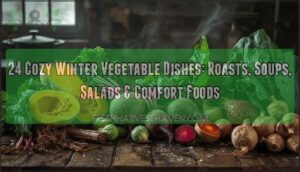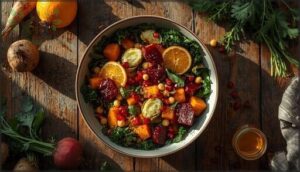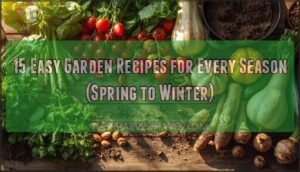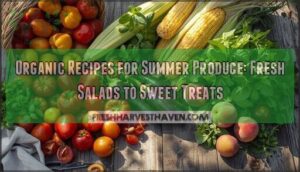This site is supported by our readers. We may earn a commission, at no cost to you, if you purchase through links.

The first frost hits and suddenly those bright summer tomatoes disappear from the farmers market, replaced by knobby roots and sturdy greens that look like they could survive a snowstorm. And honestly? That’s when the real magic happens in the kitchen.
Winter vegetables—Brussels sprouts, butternut squash, beets, kale—aren’t just cold-weather substitutes. They’re flavor powerhouses that caramelize into something remarkable when you roast them, simmer them, or toss them into a bowl with the right ingredients.
Whether you’re craving a steaming bowl of soup, a sheet pan of golden roasted veggies, or a hearty comfort dish that warms you from the inside out, these 24 winter vegetable dishes prove that eating seasonally doesn’t mean sacrificing flavor or variety.
Table Of Contents
- Key Takeaways
- Best Roasted Winter Vegetable Dishes
- Hearty Winter Vegetable Comfort Foods
- Nutritious Winter Vegetable Soups and Stews
- Vibrant Winter Vegetable Salads
- Creative Winter Vegetable Sides and Appetizers
- Frequently Asked Questions (FAQs)
- Where can I find healthy winter vegetable recipes?
- What vegetables can you eat in winter?
- What can I cook with cold weather vegetables?
- How do you eat a roasted vegetable in winter?
- What to eat in winter?
- Are roasted vegetables good for winter?
- What vegetables are eaten in the winter?
- What do you do with your vegetables in the winter?
- What is the best vegetarian food for winter?
- What are some winter dishes?
- Conclusion
Key Takeaways
- Roasting winter vegetables like Brussels sprouts, squash, and beets brings out deep sweetness, boosts nutrients, and creates cozy flavors perfect for cold nights.
- Hearty comfort dishes—think shepherd’s pie, lasagna, and Buddha bowls—use winter produce to deliver filling, protein-rich meals that warm you up and nourish you.
- Soups and stews packed with roots, squashes, and greens offer immune-boosting vitamins and satisfying textures, making them go-to choices for winter wellness.
- Vibrant salads and inventive sides, such as citrus slaws and roasted veggie dips, prove that winter vegetables can be fresh, colorful, and full of bold taste even in the coldest months.
Best Roasted Winter Vegetable Dishes
Roasting brings out the sweetness and depth in winter vegetables, turning simple ingredients into something special. If you’re craving that cozy, caramelized flavor, these dishes are just what you need.
Here are your must-try options for roasting this season.
Roasted Brussels Sprouts
Brussels sprouts might surprise you—roasting transforms them from bitter to sweet, thanks to caramelization and Maillard reactions. With simple roasting techniques, you get crisp edges and tender centers, plus nutrient retention for vitamin C and K.
Flavor enhancement and phytochemical benefits go hand in hand, making this a star in healthy winter eating and roasted vegetable recipes.
Cooking safety is simple, too. For the best results, consider using healthy cooking methods to bring out their natural flavor.
Roasted Winter Vegetables With Maple Glaze
If you’re ready for sweetness to meet savory, maple-glazed roasted vegetables are your answer. Roasting at around 425°F caramelizes winter roots and squash, while a light drizzle of maple syrup adds warmth and trace minerals. You’ll get roughly 140 calories per cup, plus fiber and vitamin A. For a delicious and healthy dish, consider using a maple glaze recipe to amplify the flavor of your roasted vegetables.
- Glaze for even browning: Stir midway to prevent scorching
- Balance flavor: Use 1 to 2 tablespoons of maple per pound
- Amplify nutrients: Roasting can boost antioxidant activity
- Layer textures: Pair with nuts or apples for complexity
Cinnamon Roasted Butternut Squash
Cinnamon-spiced butternut squash brings sweetness front and center. Roast cubes at 400°F for 25 to 30 minutes until tender and caramelized—you’ll reveal 220 calories, 7 grams of fiber, and over 200% of your daily vitamin A per serving.
That carotenoid punch bolsters vision and immunity, while the warm spice underscores why butternut squash anchors so many winter vegetable recipes and oven-roasted comfort meals.
Easy Roasted Beets
Beets bring that same earthy sweetness, plus a serious nutrition boost. Toss cubes with olive oil and thyme, roast at 400°F for 35 to 40 minutes, and you’ll release 305 mg of potassium and 80 μg of folate per serving—nutrients that support blood pressure and cell health.
These oven-roasted root vegetables also deliver dietary nitrates, compounds linked to improved vascular function and better exercise efficiency in healthy eating plans.
Roasted Spaghetti Squash
This golden winter squash delivers a noodle-like texture with just 42 calories per cup—about 18% of regular pasta’s calorie count. Halve it lengthwise, roast cut side down at 400°F for 30 to 40 minutes, then scrape out those tender strands.
- Provides 2 grams of fiber and notable vitamin C per serving
- Stores up to 2 months in a cool, dry spot
- Works as a gluten-free, low carb alternative in spaghetti recipes
Crispy Smashed Potatoes
You’ll get creamy insides and shatteringly crisp edges when you boil small potatoes for 15 to 20 minutes, gently press them flat, then roast at 450°F for about 20 minutes.
Boil small potatoes, press them flat, then roast at 450°F for creamy insides and shatteringly crisp edges
This method delivers roughly 68 grams of carbs and 7 grams of fiber per serving—comfort food that pairs beautifully with roasted carrots and other root vegetables in winter soups.
Hearty Winter Vegetable Comfort Foods
When the cold settles in, nothing beats the comfort of a hearty winter dish packed with vegetables. These recipes bring warmth and flavor to your table, using the best of the season.
Here are a few cozy options to try next.
Winter Vegetable Shepherd’s Pie
Ever layered lentils, carrots, and peas beneath pillowy mashed potatoes? That’s the soul of Winter Vegetable Shepherd’s Pie—a comfort food recipe that’s hearty, meatless, and packed with nutrient boosters.
With smart winter veggie prep and clever shepherds pie fillings, you’ll enjoy a warming, protein-rich dish that fits right into your favorite vegetarian winter options and vegetable recipes.
Roasted Winter Vegetable Lasagna
Who says lasagna can’t be a winter showstopper? With roasted vegetable layers—think cauliflower, zucchini, and squash—you’ll get deep flavor profiles and a hearty bite.
Smart roasting techniques coax out caramelized sweetness, while whole-grain noodles boost lasagna nutrition.
It’s a meal planning dream: comforting, packed with nutrients, and perfect for winter vegetable recipes or vegetarian winter options.
Winter Vegetable Buddha Bowl
Why settle for bland when your bowl can be a riot of color and nutrients? A Winter Vegetable Buddha Bowl is a meal prep dream—nutrient dense, packed with vegan options, and brimming with fiber benefits.
Toss roasted carrots, kale, and chickpeas over whole grains for a healthy bowl that’s as satisfying as any winter soup or salad.
Veggie Tikka Masala
Craving a hug in a bowl? Veggie Tikka Masala brings Indian flavors to your winter table, with plant-based protein from tofu or chickpeas and a nutrient profile that rivals classic comfort food recipes. Warm spice blends meet roasted winter vegetables for a meal that’s both cozy and nourishing.
- Veggie protein keeps you full
- Spice blends add depth
- Vegetarian options abound
Instant Pot Turmeric Chicken and Root Vegetables
When you want comfort food without the fuss, toss chicken thighs and chunky root vegetables into your Instant Pot with golden turmeric.
This one-pot wonder delivers roughly 350–450 calories per serving, about 30 grams of protein, and a generous dose of vitamin A from carrots—all in under 45 minutes.
Perfect for busy weeknights when you’re craving something warm and nourishing.
Polenta With Mushroom Ragu
Creamy polenta crowned with earthy mushroom ragu brings Italian comfort straight to your winter table.
This vegetarian hearty meal clocks in around 450–650 calories per serving and delivers impressive nutrition—roughly 43% of your daily protein, 62% of fiber, and a hefty dose of vitamin D from those savory mushrooms.
It’s winter cooking at its coziest, transforming simple ingredients into pure comfort food magic.
Nutritious Winter Vegetable Soups and Stews
When the temperature drops, nothing beats a steaming bowl of soup or stew packed with winter’s best vegetables. These recipes turn hearty roots, squashes, and greens into nourishing meals that warm you from the inside out.
From velvety purees to chunky, brothy bowls, here are five soups and stews you’ll want on repeat all season long.
Butternut Squash Soup
This velvety bowl of comfort food hits the spot when the temperature drops. Rich in squash nutrition—one cup delivers nearly 300% of your daily vitamin A—butternut squash soup variations range from simple to elaborate:
- Classic pureed with vegetable blending for silky texture
- Topped with crispy sage and toasted pepitas
- Swirled with coconut cream for extra richness
- Seasoned with warming spices like cinnamon
Healthy simmering brings out the natural sweetness in this seasonal produce cooking staple, making it a winter soups favorite that nourishes body and soul.
Rustic Roasted Winter Vegetable Chowder
For heartier winter chowder, try roasting butternut squash, carrots, parsnips, and sweet potatoes at 400°F for 40 minutes before simmering in vegetable broth. These oven-roasted vegetables develop caramelized flavor profiles that shine in this nutrient-dense bowl—one serving can deliver over 100% of your daily vitamin A. Partially blend the mixture for creamy thickness without heavy cream.
This approach transforms winter squash and root vegetables into comforting vegetable recipes for fall that warm you from the inside out.
| Winter Vegetable Recipes | Roasting Techniques |
|---|---|
| Butternut squash chunks | 400°F, 40 minutes |
| Diced sweet potatoes | Toss with olive oil |
| Parsnip coins | Spread evenly on pan |
| Carrot rounds | Season with thyme |
| Fennel wedges | Caramelize edges |
Roasted Cauliflower and Chickpea Stew
This protein-packed bowl marries roasted cauliflower florets with tender chickpeas in a warming tomato-spiced broth—delivering roughly 300 calories and impressive chickpea nutrition per serving. Roast your cauliflower at 400°F until golden before simmering with chickpeas, earning you both vegetable pairing magic and healthy comfort that satisfies.
- Turmeric and cumin enhance cauliflower benefits while adding anti-inflammatory properties
- One serving provides about 15g protein from chickpeas alone
- Pair with couscous or yogurt to round out this complete winter vegetable recipe
- Roasted edges bring caramelized sweetness to balance savory stew recipes
- Total cooking time stays under an hour for weeknight-friendly comfort food
One-Pot Harissa Beet Soup
This vibrant bowl simmers 2 pounds of red beets with potatoes in low-sodium broth, blending harissa spice’s capsaicin kick with beet nutrition’s blood pressure benefits for a warming winter comfort dish.
You’ll spend just 40 minutes of largely hands-off time creating this healthy recipe that delivers roughly 113 calories, 4 grams of fiber, and serious winter cooking satisfaction per serving.
Spicy Turkey Sausage & Kale Chili
This hearty chili recipe brings together lean turkey sausage and nutrient-packed kale for a bowl that delivers roughly 393 calories and 35 grams of protein per serving.
You’ll love how the capsaicin from chili peppers fires up your metabolism while kale supplies over 270 percent of your daily vitamin A.
It’s winter comfort that actually fuels your body right.
Vibrant Winter Vegetable Salads
You mightn’t think of salads when the weather turns cold, but winter vegetables bring bold colors and satisfying textures that feel hearty enough for the season.
From peppery greens to roasted roots, these combinations balance bright citrus notes with earthy depth.
Here are six vibrant salads that prove fresh doesn’t have to mean lightweight.
Winter Rainbow Panzanella
When you’re craving a salad that doesn’t wilt under winter’s chill, this dish is your answer. Toss roasted butternut squash, massaged kale, and toasted whole-grain bread with a balsamic vinaigrette for a texture-rich meal that checks every box.
- Phytonutrient benefits shine through orange squash, dark greens, and ruby pomegranate arils
- Kale nutrition delivers fiber and vitamin K without weighing you down
- Mediterranean diet principles guide the olive oil and whole-grain base
It’s winter salad ideas meeting sheet-pan panzanella simplicity.
Winter Vegetable Slaw With Citrus Vinaigrette
Shredded kale and cabbage meet zippy orange juice and apple cider vinegar in a bowl that stays crisp for days. This slaw’s textures come alive with matchstick carrots and apples, then you toss in toasted pepitas for crunch.
Citrus variations keep winter nutrition interesting while vegetable pairings deliver vitamin C and fiber—seasonal produce that transforms everyday winter salads into something you’ll actually crave.
Shaved Brussels Sprouts Salad
Thin ribbons of Brussels sprouts hold their crunch longer than most winter salads, and that raw texture brings you 85 mg of vitamin C per 100 grams—almost your full day’s worth.
Toss those shaved cruciferous layers with blue cheese, dried cranberries, and a Dijon vinaigrette to balance natural bitterness while fiber content (about 3.8 grams per serving) aids digestion through the coldest months.
Baby Kale Salad With Lemon and Parmesan
Baby kale brings you 200 percent of your daily vitamin A and 120 percent of your vitamin C in every 100-gram handful, making this winter green a standout for immune support.
Dress those tender leaves with fresh lemon juice and shaved Parmesan—you’ll get a calcium boost (36 percent daily value per ounce of cheese) alongside bright acidity that cuts through cold-weather heaviness.
Farro & White Bean Salad
Chewy farro brings whole-grain goodness—10 to 13 grams of fiber per serving—while white beans add plant-based protein that keeps you satisfied through cold afternoons.
Toss them with:
- Fresh parsley and mint for brightness
- Lemon juice to wake up the grain’s nutty flavor
- Cucumbers and tomatoes for crunch
- Olive oil to carry every taste
- Crumbled feta for salty richness
You’ll get around 330 to 506 calories of steady energy.
Endive Salad With Walnuts and Pears
Crisp Belgian endive leaves hold 193 percent of your daily vitamin K and nearly three grams of fiber per 100 grams, while half a pear adds another 18 to 24 percent of your fiber goal. Toss with a quarter-cup of walnuts—rich in omega-3s and healthy fats—and a light vinaigrette to balance the endive’s pleasant bitterness with the pear’s natural sweetness.
| Ingredient | Key Nutrient | Taste Profile |
|---|---|---|
| Belgian Endive | Vitamin K, Folate | Crisp, slightly bitter |
| Fresh Pear | Fiber, Vitamin C | Sweet, juicy |
| Chopped Walnuts | Omega-3, Protein | Rich, earthy |
Creative Winter Vegetable Sides and Appetizers
Winter vegetables shine just as brightly when you turn them into shareable sides and appetizers that feel cozy yet unexpected. You can roast carrots into creamy dips, mash sweet potatoes with savory twists, or toss cabbage into a bright slaw that cuts through heavier winter meals.
These dishes bring color and warmth to your table without stealing the spotlight from the main event.
Roasted Garlic Tahini Carrot Dip
Roasting carrots with garlic transforms humble roots into a creamy, golden dip that’s both nourishing and surprisingly refined. When you blend those caramelized vegetables with tahini and a drizzle of olive oil, you’re creating something that showcases carrot nutrition and tahini benefits in every spoonful.
Here’s what makes this dip a winter cooking idea worth keeping on repeat:
- Roast carrots at 200°C until tender and sweet
- Blend with tahini for protein and healthy fats
- Add roasted garlic for depth and cardiovascular support
- Adjust consistency with olive oil or lemon juice
- Serve with crudités or as part of a vegetable salad spread
The roasting techniques here aren’t complicated—you’re simply coaxing out natural sugars while softening fibers that help carotenoid absorption. This belongs among your healthy winter meals, especially when you want something plant-based that feels indulgent. Dip variations are endless: try adding cumin, smoked paprika, or a handful of chickpeas for extra body.
Beet and Walnut Dip
This earthy spread combines beetroot’s vibrant betalains—delivering antioxidant activity up to 88% in some assays—with walnuts, which rank among the highest plant foods for polyphenol content. You’ll roast beets until tender, then pulse them with toasted walnuts, a splash of lemon, and olive oil. The result is a dip that pairs beautifully with warm pita or crudités, showcasing winter vegetable recipes at their simplest and most satisfying.
| Component | Key Nutrient | Why It Matters |
|---|---|---|
| Cooked Beets | 2.6 g fiber per 100 g | Aids digestion and satiety |
| Walnuts | Alpha-linolenic acid | Heart-healthy omega-3 fat |
| Olive Oil | Monounsaturated fat | Enhances nutrient absorption |
| Lemon Juice | Vitamin C | Boosts antioxidant synergy |
Savory Mashed Sweet Potatoes
You can swap out the sugar-laden casseroles and give sweet potato nutrition a savory spin. These mashed recipes layer garlic, fresh herbs, and a hint of butter or sour cream for comfort food that feels both indulgent and wholesome—perfect winter comforts when you crave hearty and satisfying meals without the cloying sweetness.
- Boil peeled cubes until fork-tender, about 15 minutes.
- Mash with butter and sour cream for creamy texture.
- Stir in minced garlic, parsley, and green onion for savory flavors.
- Season with salt and pepper to balance the natural sweetness.
Rosemary Sweet Potatoes
Fragrant rosemary transforms sweet potato nutrition into something earthy and memorable. Toss two-pound batches of one-inch cubes with olive oil, fresh rosemary, salt, and pepper, then roast at 400–425°F for about 25–30 minutes until caramelized.
These oven-roasted winter vegetables deliver roughly 380 percent of your daily vitamin A per cup, making herbal pairings both flavorful and nourishing in seasonal recipes.
Sheet-Pan Panzanella With Arugula
You’ll love how Sheet-Pan Panzanella with Arugula combines crusty bread, roasted winter squash, and peppery greens into one vibrant Mediterranean diet staple.
Toss eight cups of cubed bread with butternut chunks, roast at 375°F for 20–30 minutes, then fold in three cups of arugula for vitamin K and glucosinolates.
This sheet pan recipe delivers around 399 calories per serving—comfort meets arugula benefits in every bite.
Classic Coleslaw With Red Cabbage
Red cabbage transforms classic coleslaw into a nutrient-dense winter side that’s equal parts crunchy and colorful. Shred your cabbage close to serving time to preserve its vitamin C—one cup delivers about 57 mg—then toss with a tangy dressing and keep refrigerated to minimize microbial risk.
- Coleslaw nutrition shines with 2 g fiber and minimal calories per serving
- Red cabbage supplies 38 µg vitamin K alongside beta-carotene
- Slice just before dressing to lock in vitamin C and crispness
- Follow food safety rules: refrigerate promptly and serve within two hours
- Pair this vegetarian staple with hearty winter vegetables for complete winter cooking menus
Frequently Asked Questions (FAQs)
Where can I find healthy winter vegetable recipes?
Looking for inspiration that won’t leave you scrolling forever? EatingWell offers over 200 healthy winter vegetable recipes—roasted dishes, soups, and one-pan meals—all tagged with fiber and calorie counts per serving.
What vegetables can you eat in winter?
Winter brings hearty root vegetables like carrots, parsnips, and sweet potatoes, plus cold-hardy greens including kale and Brussels sprouts.
You’ll also find winter squash, cabbage, beets, and turnips—all nutrient-dense options packed with seasonal produce goodness.
What can I cook with cold weather vegetables?
Cold weather vegetables shine in everything from hearty meals and comforting dishes to roasted vegetables with maple glaze.
Try winter stew recipes, cold weather casseroles, or simple seasonal meal planning using winter squash.
How do you eat a roasted vegetable in winter?
You can enjoy oven-roasted vegetables as a standalone side dish, toss them into grain bowls with quinoa or farro, fold them into hearty meals like lasagna, or layer them over fresh salads for added warmth and texture.
What to eat in winter?
Picture a steaming bowl of butternut squash soup on a January evening—that’s cold weather meals done right. You’ll want nutrient dense foods like roasted root vegetables, hearty vegetarian recipes with kale, and comfort food that enhances winter nutrition through seasonal eating.
Are roasted vegetables good for winter?
Absolutely—roasted vegetables shine in winter nutrition. Roasting boosts the bioavailability of beta carotene in carrots and squash, preserves fiber, and uses minimal water, keeping more vitamins intact than boiling while delivering satisfying comfort food warmth.
What vegetables are eaten in the winter?
When temperatures drop, you’ll find Brussels sprouts, kale, butternut squash, and parsnips waiting at markets.
Root vegetables, brassica crops, and leafy greens thrive as cold season produce throughout winter’s gentle slumber.
What do you do with your vegetables in the winter?
In winter, I lean into Vegetable Planning and Winter Storage, roasting root veggies for nutrient preservation, prepping hearty Winter Veggie Dishes, and whipping up Comfort Food classics.
Seasonal Cooking keeps meal prep fresh, with creative Winter Produce Recipes for cozy, nourishing plates.
What is the best vegetarian food for winter?
Roasted root vegetables, hearty stews packed with kale and squash, and vibrant grain bowls with beans and sweet potatoes deliver Winter Nutrition, Vegetarian Benefits, Immune Support, and Sustainable Food—making these Vegetable-Based Recipes the soul of cozy, nourishing Winter Meals.
What are some winter dishes?
When you’re craving comfort food, think Winter Stews, Hearty Casseroles, Roasted Roots, and Seasonal Salads.
These Winter Meals turn simple vegetables into Gourmet Winter Recipes—nutritious, satisfying, and perfect for Healthy Winter Recipes and cozy gatherings.
Conclusion
Winter’s wonders whisper in every bite, bringing bold flavors and comforting warmth to your table. Whether you’re roasting, simmering, or tossing together vibrant salads, these winter vegetable dishes transform cold nights into cozy celebrations.
Let the earthy sweetness of squash, the crunch of kale, and the golden glow of roasted roots remind you: the season’s bounty is anything but bleak.
So grab your favorite pan, gather loved ones close, and savor the simple pleasure of fresh, seasonal cooking.
- https://www.eatthismuch.com/calories/winter-vegetable-salad-967753
- https://www.abrinternationaljournal.org/articles/a-review-nutritional-value-of-winter-vegetables-110322.html
- https://www.mynetdiary.com/food/calories-in-winter-vegetables-by-market-fare-gram-31777417-0.html
- https://www.nutrition.va.gov/docs/Recipes/MainDishes/WinterVegetableSoupMay2021.pdf
- https://diabetesfoodhub.org/recipes/roasted-winter-vegetables













